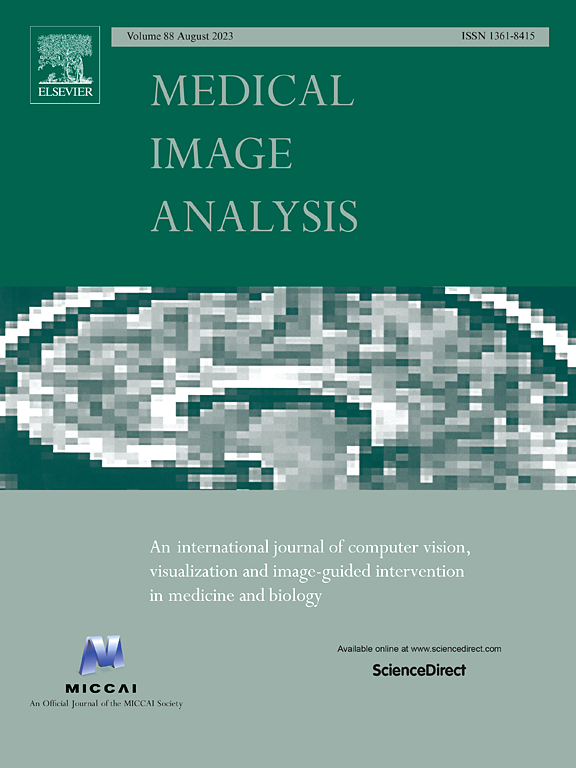Deep learning based coronary vessels segmentation in X-ray angiography using temporal information
IF 10.7
1区 医学
Q1 COMPUTER SCIENCE, ARTIFICIAL INTELLIGENCE
引用次数: 0
Abstract
Invasive coronary angiography (ICA) is the gold standard imaging modality during cardiac interventions. Accurate segmentation of coronary vessels in ICA is required for aiding diagnosis and creating treatment plans. Current automated algorithms for vessel segmentation face task-specific challenges, including motion artifacts and unevenly distributed contrast, as well as the general challenge inherent to X-ray imaging, which is the presence of shadows from overlapping organs in the background. To address these issues, we present Temporal Vessel Segmentation Network (TVS-Net) model that fuses sequential ICA information into a novel densely connected 3D encoder-2D decoder structure with a loss function based on elastic interaction. We develop our model using an ICA dataset comprising 323 samples, split into 173 for training, 82 for validation, and 68 for testing, with a relatively relaxed annotation protocol that produced coarse-grained samples, and achieve 83.4% Dice and 84.3% recall on the test dataset. We additionally perform an external evaluation over 60 images from a local hospital, achieving 78.5% Dice and 82.4% recall and outperforming the state-of-the-art approaches. We also conduct a detailed manual re-segmentation for evaluation only on a subset of the first dataset under strict annotation protocol, achieving a Dice score of 86.2% and recall of 86.3% and surpassing even the coarse-grained gold standard used in training. The results indicate our TVS-Net is effective for multi-frame ICA segmentation, highlights the network’s generalizability and robustness across diverse settings, and showcases the feasibility of weak supervision in ICA segmentation.
基于深度学习的冠状血管分割在x线血管造影中的应用
有创冠状动脉造影术(ICA)是心脏介入治疗的金标准成像方式。在 ICA 中对冠状动脉血管进行准确分割是辅助诊断和制定治疗计划的必要条件。目前用于血管分割的自动算法面临着特定任务的挑战,包括运动伪影和对比度分布不均,以及 X 射线成像固有的一般挑战,即背景中存在重叠器官的阴影。为了解决这些问题,我们提出了时空血管分割网络(TVS-Net)模型,该模型将连续的 ICA 信息融合到新颖的密集连接三维编码器-二维解码器结构中,并具有基于弹性相互作用的损失函数。我们使用由 323 个样本组成的 ICA 数据集开发了我们的模型,这些样本分为 173 个训练样本、82 个验证样本和 68 个测试样本,我们采用了相对宽松的注释协议来生成粗粒度样本,并在测试数据集上实现了 83.4% 的 Dice 率和 84.3% 的召回率。此外,我们还对当地一家医院的 60 幅图像进行了外部评估,结果显示 Dice 和召回率分别为 78.5% 和 82.4%,优于最先进的方法。我们还在严格的注释协议下,仅对第一个数据集的一个子集进行了详细的人工重新分割评估,取得了 86.2% 的 Dice 分数和 86.3% 的召回率,甚至超过了训练中使用的粗粒度黄金标准。结果表明,我们的 TVS 网络能有效地进行多帧 ICA 分割,突出了该网络在不同环境下的通用性和鲁棒性,并展示了弱监督在 ICA 分割中的可行性。
本文章由计算机程序翻译,如有差异,请以英文原文为准。
求助全文
约1分钟内获得全文
求助全文
来源期刊

Medical image analysis
工程技术-工程:生物医学
CiteScore
22.10
自引率
6.40%
发文量
309
审稿时长
6.6 months
期刊介绍:
Medical Image Analysis serves as a platform for sharing new research findings in the realm of medical and biological image analysis, with a focus on applications of computer vision, virtual reality, and robotics to biomedical imaging challenges. The journal prioritizes the publication of high-quality, original papers contributing to the fundamental science of processing, analyzing, and utilizing medical and biological images. It welcomes approaches utilizing biomedical image datasets across all spatial scales, from molecular/cellular imaging to tissue/organ imaging.
 求助内容:
求助内容: 应助结果提醒方式:
应助结果提醒方式:


